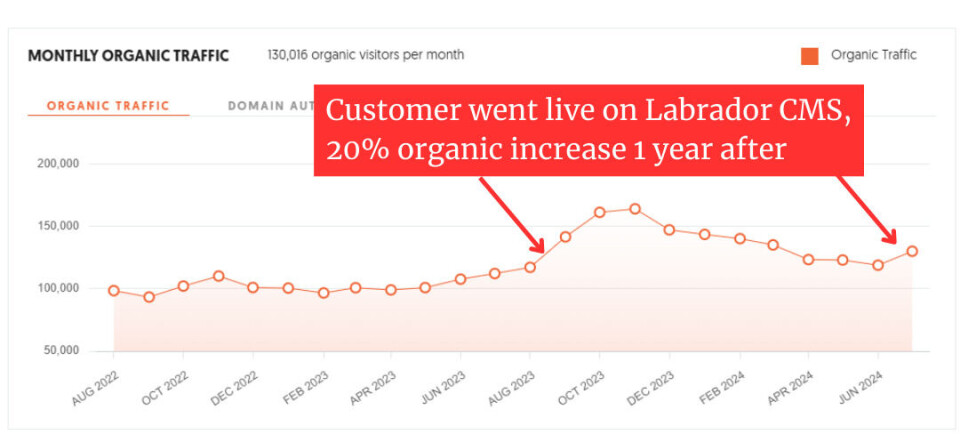Search Engine Optimalization built into the CMS

How 72% of our customers increased their search traffic
Discover how switching to Labrador CMS significantly increased search traffic for over 72% of our clients.
Recently, we conducted a web traffic analysis of our clients. The results were better than we could have imagined.
Across 72% of our clients, web traffic increased as a result of switching to Labrador CMS. This was the result after exploring incoming search traffic for more than 25 recently onboarded customers.
One customer saw an immediate growth in search traffic of 50% the first three months after migration. Keep in mind that a migration in itself is a risk of losing traffic. This customer gained. Even after 1 year, it still has 20-30% more traffic from search than before the migration.
This is a typical pattern. This proves the importance of obsession for details when it comes to Search Engine Optimization. One thing is what you do with your content and optimize that for findability. Another thing is all the technical details that need to be in place for your site to rank above all other competitors. Some experts call SEO, jokingly, for Seemingless Effortless Optimization. Meaning you do a lot of small improvements to the technical quality of your site. Each one of them does not seem to make any difference. But the combination of all the small pieces, when they come together, is better ranking, faster load times, better user experience and ranking improves.

Labrador CMS is a prebuilt system and we collaborate on tech improvements with our customers. There are hundreds of seo optimized features in Labrador. Most of them will never be visible for you as a user of the system.
Performance: Fast loading and proper structure
Labrador CMS is designed with speed and efficiency in mind. Our platform optimizes load times and ensures that content is delivered quickly and reliably to users. Faster websites not only enhance user experience but also rank better on search engines, driving more traffic.
Faster image support: Our image server does a lot of magic. While we store the high res image in the built in asset management system, we prepare the end user images for the fastest delivery possible, including providing support for webp image format, adjustable pixel density, lazy loading and an ultrafast setup for global caching.
Load faster: If you want your First Contentful to appear ultrafast, you can turn on placeholder rendering of images and turn off preloading of your custom fonts. Also, we do a lot of Varnish and CloudFront magic to blast those pages out to your mobile. That includes global cache.
Tidy behind the scenes: Most of the work in a CMS happens behind the scenes. That's true with SEO optimization as well. Meaning you have to have all that metadata and microformats in place. Your sitemap should be stellar, including your Google News sitemap.
Optimize content for SEO
With features like automated SEO text generation and optimized metadata, our platform helps clients achieve better visibility in search results, which directly leads to increased traffic.
AI-Driven SEO Features
Some of the top AI features include:
Automatic SEO title generation: Suggests SEO-friendly titles + A/B tests to increase click-through rates.
Automated summaries: Generates concise fact boxes and summaries that improve user engagement, user on-page time, and search engine visibility.
Automated tagging: Ensures consistent tagging for better content organization and search optimization. Tags better than most reporters.
Translation and Localization: Translates content into multiple languages, expanding reach to global audiences.
These AI-driven features not only save time for content creators but also ensure that content is optimized for maximum search engine visibility.
Mobile-First Approach
Labrador CMS ensures that content is fully optimized for mobile devices. Google looks at your mobile experience first.
Google’s mobile-first indexing: Mobile accessibility and site performance now heavily outweigh that of the desktop. Labrador CMS allows you to edit the adaptive & mobile in a WYSIWYG format. Ensuring mobile presentability and lets you write for mobile.
Improved User Experience: When writing for mobile, you want to have as low bounce as possible. A better user experience leads to longer session durations, lower bounce rates, and higher engagement. We do that by allowing you to move content objects on mobile only, to align better with optimal finger and touch navigation and scroll.




